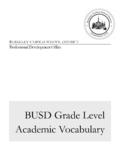Transcription of Technology Review Level Measurement of Bulk …
1 Technology Review Level Measurement of Bulk Solids in Bins, Silos and Hoppers Joseph D. Lewis, Sr. Vice President Marketing & Sales December 2004. 2004 Monitor Technologies LLC. Technology Review Level Measurement of Bulk Solids and Powders in Bins, Silos and Hoppers 2004 Monitor Technologies LLC. Introduction Trying to measure the Level of bulk solids or powders in a bin or silo can be difficult for several reasons. Many of these reasons are related to the need to convert Level to volume and mass, as well as the nature of the material itself which often behaves in a manner that makes obtaining a Level Measurement difficult, or makes the accuracy of the Measurement questionable. Let's take a closer look at these reasons: 1. The material can be extremely light or very heavy. 2. Bulk solids can be fine micron size powders or large with sharp edges.
2 3. Many materials produce large amounts of dust during filling and discharging. 4. Some materials are hygroscopic and readily absorb or trap moisture, and moisture can combine with solids to cake or clump inside a vessel making material flow difficult and presenting challenges to some of the available Level Measurement technologies. 5. Solids stored in a vessel do not have a flat, horizontal surface like virtually all liquids. The surface of powders and granular materials has an angle of repose. This angle of repose, or shape of the surface, can vary with filling, discharging, the location of filling and discharging, angled or multiple fill points, multiple draw points, etc. 6. The coarser the material, the more likely it is to clump, bridge, leave voids and pile up. 7. Pneumatic conveying systems aerate material.
3 The bulk density changes in storage as the material compacts with time. 8. It may be difficult to know an accurate value for the bulk density for materials like corn and flour that vary from season to season, and are dependent on specific crop and blend. 9. It also can be difficult to know the exact dimensions of the silo the material is stored within. 1. Technology Review Level Measurement of Bulk Solids and Powders in Bins, Silos and Hoppers 2004 Monitor Technologies LLC. These issues are just the tip of the iceberg in regards to the problems that can be encountered. They can have a major impact on selecting a Technology to measure how much material resides in the vessel at any given time. There are several technologies that can be used to determine the material Level or amount of bulk solids within a storage silo.
4 These technologies are sensitive to the specific application, some more so than others. The selection of the wrong device can waste time, money, manpower, and generate a good deal of frustration for all involved. Manufacturers of Level Measurement technologies are often asked to recommend a Technology for measuring bulk solids in vessels. We feel that an objective Review and understanding of the technologies available will be advantageous to anyone needing to speak with manufacturers in their search for an answer to the question of what to do . After reading a great deal of material, and investigating the options with several manufacturers ourselves, we have created a list of pros and cons for all the major technologies to help objectively make a selection of the best Technology for a given application.
5 We are presenting the results of our Review in hopes that it will prove helpful to you, should you be involved in such applications. To begin our Review let's first identify the technologies typically available for these applications. Who Are The Players? Continuous Measurement of the Level or amount of solids in bins, hoppers and silos is dominated by the following technologies: Weight & Cable (plumb-bob, yo-yo, etc.). Ultrasonic Guided Wave Radar Thru-Air Radar Laser Load Cells Strain Gages Please note that Weight & Cable systems, while not really continuous, are used in applications where Level Measurement updates as frequent as once every 15. minutes are acceptable. These devices are used to measure the changing Level of material and calculate volumes and weights, and are therefore included in our Review .
6 2. Technology Review Level Measurement of Bulk Solids and Powders in Bins, Silos and Hoppers 2004 Monitor Technologies LLC. The first four technologies on the list all measure the distance from the sensor location to the surface of the material and consequently the height of the material in the vessel. Load cells and strain gages infer the mass of material by measuring the force exerted on a sensing element. If you read most technical journals, or surf the Internet, you will find that newer technologies (like radar and laser) promise to eliminate the frustrations users may have experienced with the more mature technologies (like weight & cable and ultrasonic). However, after closer examination we also find that those same mature technologies have made significant design advancements in recent years, and promise to be vastly more reliable than earlier generations of products.
7 Our purpose, as stated previously, is to objectively Review the pros and cons of each Technology as it is important in assessing a Technology 's compatibility with a specific application, and in making a cost effective decision on what to use. This is true whether you are looking to buy an instrument for a new application, or looking to replace a device previously in service. To keep this discussion at a reasonable length, we will not perform an in-depth Review of individual operating principles, as they are well documented elsewhere. Only general information is presented, intended to be objective and not reflect a particular manufacturer's design. We also will provide a list of leading manufacturers in each Technology area. Anyone interested should refer to manufacturer's literature to Review product features and the full range of specifications.
8 The comments we make here for each Technology are based on what we have been able to ascertain as being the current state-of-the-art. The end user must discern whether a product has sufficient design features, especially on the tougher applications, so as to obtain the full performance benefits that Technology has to offer. The Starting Point Before getting into the pros and cons of the various technologies, and before you start to check out prices and features, it is necessary to clearly define the application and what you are trying to accomplish. From an application engineering perspective we recommend you answer the following questions: 1. Do you need continuous or intermittent (as frequent as every 15 minutes). Measurement ? If the latter, what frequency of Measurement do you need?
9 2. Do you need to measure during filling? 3. Technology Review Level Measurement of Bulk Solids and Powders in Bins, Silos and Hoppers 2004 Monitor Technologies LLC. 3. Do you need to know just the Level of the material, or also the volume or mass of the material in the vessel? 4. What real world accuracy are you looking to achieve? Is this in terms of the Level of the material or volume/mass? 5. What are the vessel dimensions and construction? How accurate is this information and how accurately can you calculate the internal vessel volume? 6. What are the physical properties and flow characteristics of the material(s). being measured? How accurate is this data? Will these parameters be constant, or can they change? 7. What are the process conditions (temperature, pressure, etc.) and how can they vary?
10 8. How is the vessel being filled and emptied? What are the fill/empty rates? What are the fill/empty distances? 9. What is the anticipated angle of repose? How will this change during filling/emptying? 10. Where is the sensor to be located? Are there any special conditions, like tight spaces, non-intrusion, sanitary requirements, 11. What kind of display, operator interface, and outputs are required? Do you want the electronics to be integrally mounted to the sensor or mounted remotely? 12. How much can you afford to spend for this functionality? Even if you don't know all the answers, and you probably don't, it's still a good idea to Review these questions and keep them in mind when looking at the pros and cons of a specific Technology . Important Considerations Regarding Real World Accuracy Accuracy is a very important selection consideration because it directly affects the purchase price of the instrument you choose to accept for your application.





